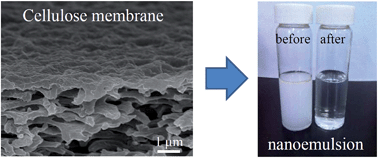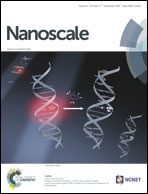Ultrathin cellulose nanosheet membranes for superfast separation of oil-in-water nanoemulsions†
Abstract
Oily wastewater is generated in diverse industrial processes, and its treatment has become crucial due to increasing environmental concerns. Herein, novel ultrathin nanoporous membranes of cellulose nanosheets have been fabricated for separation of oil-in-water nanoemulsions. The fabrication approach is facile and environmentally friendly, in which cellulose nanosheets are prepared by freeze-extraction of a very dilute cellulose solution. The as-prepared membranes have a cellulose nanosheet layer with a cut-off of 10–12 nm and a controllable thickness of 80–220 nm. They allow ultrafast water permeation and exhibit excellent size-selective separation properties. A 112 nm-thick membrane has a water flux of 1620 l m−2 h−1 bar−1 and a ferritin rejection of 92.5%. These membranes have been applied to remove oil from its aqueous nanoemulsions successfully, and they show an ultrafast and effective separation of oil-in-water nanoemulsions. The newly developed ultrathin cellulose membranes have a wide application in oily wastewater treatment, separation and purification of nanomaterials.


 Please wait while we load your content...
Please wait while we load your content...